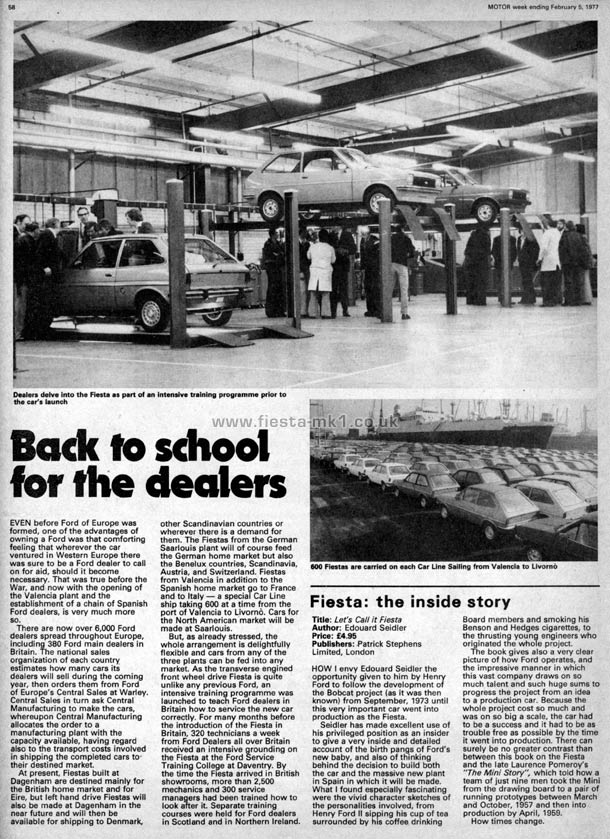Copy of Article Text Below
Back to school for the dealers
Even before Ford of Europe was formed, one of the advantages of owning a Ford was that comforting feeling that wherever the car ventured in Western Europe there was sure to be a Ford dealer to call on for aid, should it become necessary. That was true before the War, and now with the opening of the Valencia plant and the establishment of a chain of Spanish Ford dealers, is very much more so.
There are now over 6,000 Ford dealers spread throughout Europe, including 380 Ford main dealers in Britain. The national sales organization of each country estimates how many cars its dealers will sell during the coming year, then orders them from Ford of Europe's Central Sales at Warley. Central Sales in turn ask Central Manufacturing to make the cars, whereupon Central Manufacturing allocates the order to a manufacturing plant with the capacity available, having regard also to the transport costs involved in shipping the completed cars to their destined market.
At present, Fiestas built at Dagenham are destined mainly for the British home market and for Eire, but left hand drive Fiestas will also be made at Dagenham in the near future and wijl then be available for shipping to Denmark, other Scandinavian countries or wherever there is a demand for them. The Fiestas from the German Saarlouis plant will of course feed the German home market but also the Benelux countries, Scandinavia, Austria, and Switzerland. Fiestas from Valencia in addition to the Spanish home market go to France and to Italy - a special Car Line ship taking 600 at a time from the port of Valencia to Livorno. Cars for the North American market will be made at Saarlouis.
But, as already stressed, the whole arrangement is delightfully flexible and cars from any of the three plants can be fed into any market. As the transverse engined front wheel drive Fiesta is quite unlike any previous Ford, an intensive training programme was launched to teach Ford dealers in Britain how to service the new car correctly. For many months before the introduction of the Fiesta in Britain, 320 technicians a week from Ford Dealers all over Britain received an intensive grounding on the Fiesta at the Ford Service Training College at Dayentry. By the time the Fiesta arrived in British showrooms, more than 2,500 mechanics and 300 service managers had been trained how to look after it. Separate training courses were held for Ford dealers in Scotland and in Northern Ireland.
Fiesta: the inside story
Title: Let's Call it Fiesta
Author: Edouard Seidler
Price: £4.95
Publishers: Patrick Stephens Limited, London
How I envy Edouard Seidler the opportunity given to him by Henry Ford to follow the development of the Bobcat project (as it was then known) from September, 1973 until this very important car went into production as the Fiesta.
Seidler has made excellent use of his privileged position as an insider to give a very inside and detailed account of the birth pangs of Ford's new baby, and also of thinking behind the decision to build both the car and the massive new plant in Spain in which it will be made. What I found especially fascinating were the vivid character sketches of the personalities involved, from Henry Ford II sipping his cup of tea surrounded by his coffee drinking Board members and smoking his Benson and Hedges cigarettes, to the thrusting young engineers who originated the whole project.
The book gives also a very clear picture of how Ford operates, and the impressive manner in which this vast company draws on so much talent and such huge sums to progress the project from an idea to a production car. Because the whole project cost so much and was on so big a scale, the car had to be a success and it had to be as trouble free as possible by the time it went into production. There can surely be no greater contrast than between this book on the Fiesta and the late Laurence Pomeroy's "The Mini Story", which told how a team of just nine men took the Mini from the drawing board to a pair of running prototypes between March and October, 1957 and then into production by April, 1959.
How times change.
Captions -
Middle-Left - Dealers delve into the Fiesta as part of an intensive training programme prior to the car's launch
Middle-Right - 600 Fiestas are carried on each Car Line Sailing from Valencia to Livorno
|












